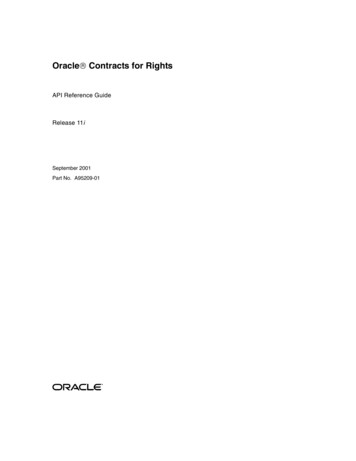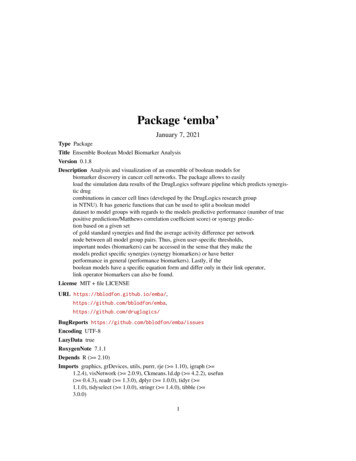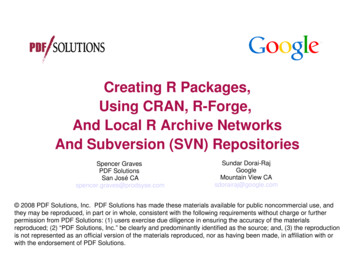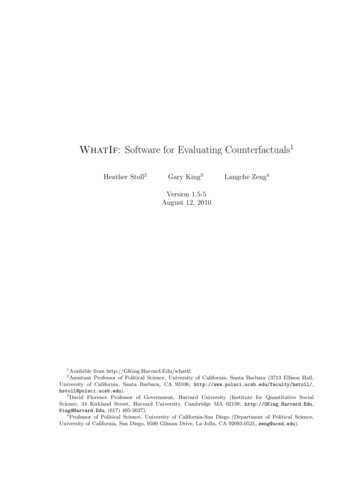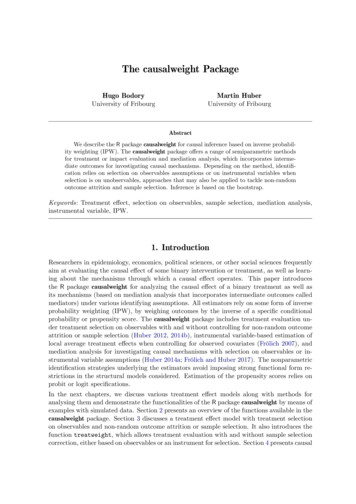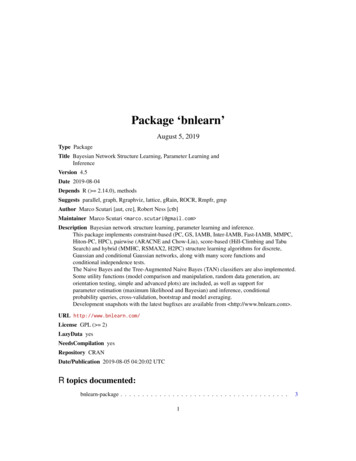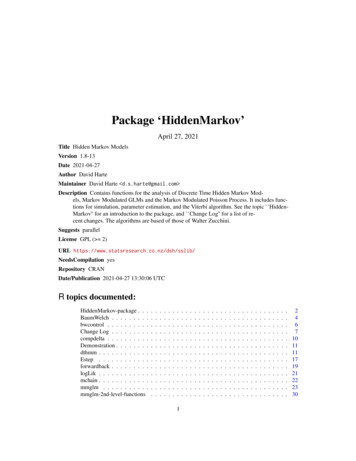
Transcription
Package ‘HiddenMarkov’April 27, 2021Title Hidden Markov ModelsVersion 1.8-13Date 2021-04-27Author David HarteMaintainer David Harte d.s.harte@gmail.com Description Contains functions for the analysis of Discrete Time Hidden Markov Models, Markov Modulated GLMs and the Markov Modulated Poisson Process. It includes functions for simulation, parameter estimation, and the Viterbi algorithm. See the topic HiddenMarkov'' for an introduction to the package, and Change Log'' for a list of recent changes. The algorithms are based of those of Walter Zucchini.Suggests parallelLicense GPL ( 2)URL pilation yesRepository CRANDate/Publication 2021-04-27 13:30:06 UTCR topics documented:HiddenMarkov-package . . .BaumWelch . . . . . . . . .bwcontrol . . . . . . . . . .Change Log . . . . . . . . .compdelta . . . . . . . . . .Demonstration . . . . . . . .dthmm . . . . . . . . . . . .Estep . . . . . . . . . . . .forwardback . . . . . . . . .logLik . . . . . . . . . . . .mchain . . . . . . . . . . . .mmglm . . . . . . . . . . 0
2HiddenMarkov-packagemmpp . . . . . . . . . . .mmpp-2nd-level-functionsMstep . . . . . . . . . . .neglogLik . . . . . . . . .probhmm . . . . . . . . .residuals . . . . . . . . . .simulate . . . . . . . . . .summary . . . . . . . . .Transform-Parameters . . .Viterbi . . . . . . . . . . verview of Package HiddenMarkovDescriptionIn this topic we give an overview of the package.Classes of Hidden Markov Models AnalysedThe classes of models currently fitted by the package are listed below. Each are defined within anobject that contains the data, current parameter values, and other model characteristics.Discrete Time Hidden Markov Model: is described under the topic dthmm. This model can besimulated or fitted to data by defining the required model structure within an object of class"dthmm".Markov Modulated Generalised Linear Model: is described under the topic mmglm1.Markov Modulated Generalised Linear Longitudinal Model: is described under the topic mmglmlong1.Markov Modulated Poisson Process: is described under the topic mmpp. This model can be simulated or fitted to data by defining the required model structure within an object of class "mmpp".Main Tasks Performed by the PackageThe main tasks performed by the package are listed below. These can be achieved by calling theappropriate generic function.Simulation of HMMs: can be performed by the function simulate.Parameter Estimation: can be performed by the functions BaumWelch (EM algorithm), or neglogLiktogether with nlm or optim (Newton type methods or grid searches).Model Residuals: can be extracted with the function residuals.Model Summary: can be extracted with the function summary.Log-Likelihood: can be calculated with the function logLik.Prediction of the Markov States: can be performed by the function Viterbi.All other functions in the package are called from within the above generic functions, and only needto be used if their output is specifically required. We have referred to some of these other functionsas “2nd level” functions, for example see the topic mmpp-2nd-level-functions.
HiddenMarkov-package3Organisation of Topics in the PackageCited References: anywhere in the manual are only listed within this topic.General Documentation: topics summarising general structure are indexed under the keyword“documentation” in the Index.AcknowledgementMany of the functions contained in the package are based on those of Walter Zucchini (2005).ReferencesBaum, L.E.; Petrie, T.; Soules, G. & Weiss, N. (1970). A maximization technique occurring in thestatistical analysis of probabilistic functions of Markov chains. Annals of Mathematical Statistics41(1), 164–171. doi: 10.1214/aoms/1177697196Charnes, A.; Frome, E.L. & Yu, P.L. (1976). The equivalence of generalized least squares andmaximum likelihood estimates in the exponential family. J. American Statist. Assoc. 71(353),169–171. doi: 10.2307/2285762Dempster, A.P.; Laird, N.M. & Rubin, D.B. (1977). Maximum likelihood from incomplete datavia the EM algorithm (with discussion). J. Royal Statist. Society B 39(1), 1–38. URL: https://www.jstor.org/stable/2984875Elliott, R.J.; Aggoun, L. & Moore, J.B. (1994). Hidden Markov Models: Estimation and Control.Springer-Verlag, New York. doi: 10.1007/9780387848549Harte, D. (2019). Mathematical Background Notes for Package “HiddenMarkov”. Statistics Research Associates, Wellington. URL: notes.pdfHartley, H.O. (1958). Maximum likelihood estimation from incomplete data. Biometrics 14(2),174–194. doi: 10.2307/2527783Klemm, A.; Lindemann, C. & Lohmann, M. (2003). Modeling IP traffic using the batch Markovianarrival process. Performance Evaluation 54(2), 149–173. doi: 10.1016/S01665316(03)000671MacDonald, I.L. & Zucchini, W. (1997). Hidden Markov and Other Models for Discrete-valuedTime Series. Chapman and Hall/CRC, Boca Raton.McCullagh, P. & Nelder, J.A. (1989). Generalized Linear Models (2nd Edition). Chapman andHall, London.Rabiner, L.R. (1989). A tutorial on hidden Markov models and selected applications in speechrecognition. Proceedings of the IEEE 77(2), 257–286. doi: 10.1109/5.18626Roberts, W.J.J.; Ephraim, Y. & Dieguez, E. (2006). On Ryden’s EM algorithm for estimatingMMPPs. IEEE Signal Processing Letters 13(6), 373–376. doi: 10.1109/LSP.2006.871709Ryden, T. (1994). Parameter estimation for Markov modulated Poisson processes. Stochastic Models 10(4), 795–829. doi: 10.1080/15326349408807323Ryden, T. (1996). An EM algorithm for estimation in Markov-modulated Poisson processes. Computational Statistics & Data Analysis 21(4), 431–447. doi: 10.1016/01679473(95)000259Zucchini, W. (2005). Hidden Markov Models Short Course, 3–4 April 2005. Macquarie University,Sydney.
4BaumWelchBaumWelchEstimation Using Baum-Welch AlgorithmDescriptionEstimates the parameters of a hidden Markov model. The Baum-Welch algorithm (Baum et al,1970) referred to in the HMM literature is a version of the EM algorithm (Dempster et al, 1977).See Hartley (1958) for an earlier application of the EM methodology, though not referred to as such.UsageBaumWelch(object, control, .)## S3 method for class 'dthmm'BaumWelch(object, control bwcontrol(),## S3 method for class 'mmglm0'BaumWelch(object, control bwcontrol(),## S3 method for class 'mmglm1'BaumWelch(object, control bwcontrol(),## S3 method for class 'mmglmlong1'BaumWelch(object, control bwcontrol(),tmpfile NULL, .)## S3 method for class 'mmpp'BaumWelch(object, control bwcontrol(),.).).)PSOCKcluster NULL,.)Argumentsobjectan object of class "dthmm", "mmglm0", "mmglm1", "mmglmlong1", or "mmpp".controla list of control settings for the iterative process. These can be changed by usingthe function bwcontrol.PSOCKclustersee section below called “Parallel Processing”.tmpfilename of a file (.Rda) into which estimates are written at each 10th iteration. Themodel object is called object. If NULL (default), no file is created.other arguments.DetailsThe initial parameter values used by the EM algorithm are those that are contained within the inputobject.The code for the methods "dthmm", "mmglm0", "mmglm1","mmglmlong1" and "mmpp" can be viewedby appending BaumWelch.dthmm, BaumWelch.mmglm0, BaumWelch.mmglm1, BaumWelch.mmglmlong1or BaumWelch.mmpp, respectively, to HiddenMarkov:::, on the R command line; e.g. HiddenMarkov:::dthmm.The three colons are needed because these method functions are not in the exported NAMESPACE.
BaumWelch5ValueThe output object (a list) with have the same class as the input, and will have the same components. The parameter values will be replaced by those estimated by this function. The object willalso contain additional components.An object of class "dthmm" will also containuan n m matrix containing estimates of the conditional expectations. See “Details” in Estep.van n m m array containing estimates of the conditional expectations. See“Details” in Estep.LLvalue of log-likelihood at the end.iternumber of iterations performed.diffdifference between final and previous log-likelihood.Parallel ProcessingIn longitudinal models, the forward and backward equations need to be calculated for each individual subject. These can be done independently, the results being concatenated to be used in theE-step. If the argument PSOCKcluster is set, subjects are divided equally between each node in thecluster for the calculation of the forward and backward equations. This division is very basic, andassumes that all nodes run at a roughly comparable speed.If the communication between nodes is slow and the dataset is small, then the time taken to allocatethe work to the various nodes may in fact take more time than simply using one processor to performall of the calculations.The required steps in initiating parallel processing are as follows.#load the "parallel" packagelibrary(parallel)#define the SNOW cluster object, e.g. a SOCK cluster#where each node has the same R installation.cl - makePSOCKcluster(c("localhost", "horoeka.localdomain","horoeka.localdomain", "localhost"))# A more general setup: Totara is Fedora, Rimu is Debian:# Use 2 processors on Totara, 1 on Rimu:totara - list(host "localhost",rscript "/usr/lib/R/bin/Rscript",snowlib "/usr/lib/R/library")rimu - list(host "rimu.localdomain",rscript "/usr/lib/R/bin/Rscript",snowlib "/usr/local/lib/R/site-library")cl - makeCluster(list(totara, totara, rimu), type "SOCK")##then define the required model objectsay the model object is called x
6bwcontrolBaumWelch(x, PSOCKcluster cl)#stop the R jobs on the slave machinesstopCluster(cl)Note that the communication method does not need to be SOCKS; see the parallel package documentation, topic makeCluster, for other options. Further, if some nodes are on other machines, thefirewalls may need to be tweaked. The master machine initiates the R jobs on the slave machinesby communicating through port 22 (use of security keys are needed rather than passwords), andsubsequent communications through port 10187. Again, these details can be tweaked in the optionssettings within the parallel package.ReferencesCited references are listed on the HiddenMarkov manual page.See AlsologLik, residuals, simulate, summary, neglogLikbwcontrolControl Parameters for Baum Welch AlgorithmDescriptionCreates a list of parameters that control the operation of BaumWelch.Usagebwcontrol(maxiter 500, tol 1e-05, prt TRUE, posdiff TRUE,converge expression(diff tol))Argumentsmaxitertolprtposdiffconvergeis the maximum number of iterations, default is 500.is the convergence criterion, default is 0.00001.is logical, and determines whether information is printed at each iteration; default is TRUE.is logical, and determines whether the iterative process stops if a negative loglikelihood difference occurs, default is TRUE.is an expression giving the convergence criterion. The default is the differencebetween successive values of the log-likelihood.Examples#Increase the maximum number of iterations to 1000.#All other components will retain their default values.a - bwcontrol(maxiter 1000)print(a)
Change LogChange Log7Changes Made to Package HiddenMarkovDescriptionThis page contains a listing of recent changes made to the package.Details1. Since we have included different classes of HMMs (see dthmm, mmglm0 and mmpp), it is muchtidier to use an object orientated approach. This ensures that the functions across all modelsfollow a more consistent naming convention, and also the argument list for the different modelfunctions are more simple and consistent (see HiddenMarkov). (14 Sep 2007)2. The main tasks (model fitting, residuals, simulation, Viterbi, etc) can now be called by genericfunctions (see topic HiddenMarkov). The package documentation has been rearranged so thatthese generic functions contain the documentation for all model types (e.g. see BaumWelch).(14 Sep 2007)3. There are a number of functions, still contained in the package, that are obsolete. This is eitherbecause they do not easily fit into the current naming convention used to implement the moreobject orientated approach, or their argument list is slightly complicated. These functions havebeen grouped in the topics dthmm.obsolete and mmpp.obsolete. (14 Sep 2007)4. There are various second level functions. For example, the model fitting is achieved by thegeneric BaumWelch function. However, this will call functions to do the E-step, M-step, forward and backward probabilities, and so on. At the moment, these second level functions havenot been modified into an object orientated approach. It is not clear at this point whether thiswould be advantageous. If one went down this route, then one would probably group all ofthe E-step functions (for all models) under the same topic. If not, then it may be best to groupall second level functions for each model under the same topic (e.g. forwardback, probhmmand Estep would be grouped together, being the second level functions for the dthmm model).(14 Sep 2007)5. The original function called Viterbi has been renamed to Viterbihmm, and Viterbi is nowa generic function. (14 Sep 2007)6. Programming code that uses old versions of the functions should still work with this revisedversion of the package. However, you will get warning messages stating that certain functions are deprecated, and suggesting a possible alternative. To get a quick overview of theprogramming style, have a look at the examples in topic dthmm. (09 Nov 2007)7. forwardback: for loops replaced by Fortran code; much faster. The corresponding R codeis still contained within the function in case the Fortran has incompatibility issues. (23 Nov2007)8. forwardback.mmpp: for loops replaced by Fortran code. The corresponding R code is stillcontained within the function in case the Fortran has incompatibility issues. (24 Nov 2007)9. Estep.mmpp: for loops replaced by Fortran code. Cuts time considerably. These loops inR used far more time than the forward and backward equations. The corresponding R codeis still contained within the function in case the Fortran has incompatibility issues. (27 Nov2007)
8Change Log10. forwardback.mmpp, forwardback and Estep.mmpp: argument fortran added. (3 Dec 2007)11. forwardback, forwardback.mmpp and Estep.mmpp: inclusion of all variable sized arrays inthe Fortran subroutine call to be compatible with non gfortran compilers (3 Dec 2007); moreadded for calls to Fortran subroutines multi1 and multi2. (6 Dec 2007)12. Estep.mmpp: error in Fortran code of loop 6; j1 0 to j1 1. (5 Dec 2007)13. BaumWelch.mmpp: if (diff 0) stop . to if (diff 0 & control posdiff) stop .,consistent with BaumWelch.dthmm. (11 Dec 2007)14. logLik.dthmm, logLik.mmglm0, logLik.mmpp: for loop replaced by Fortran code. (15 Feb2008)15. dthmm: argument discrete set automatically for known distributions, stops if not set forunknown distributions. (15 Feb 2008)16. neglogLik, Pi2vector, vector2Pi, Q2vector, vector2Q: new functions providing an alternative means of calculating maximum likelihood parameter estimates. (18 Feb 2008)17. dthmm: argument nonstat was not set correctly. (21 Jun 2008)18. Hyperlinks on package vignettes page. (22 Jun 2008)19. mmpp: argument nonstat was not set correctly. (23 Jun 2008)20. The manual pages HiddenMarkov-dthmm-deprecated and HiddenMarkov-mmpp-deprecatedhave been given a keyword of “internal”. This hides them from the listing of package functions. (3 Jul 2008)21. All cited references are now only listed in the topic HiddenMarkov. (3 Jul 2008)22. neglogLik: argument updatep has been renamed to pmap. (9 Jul 2008)23. neglogLik: format of this function changed to be consistent with that in package PtProcess.Argument p renamed as params. (07 Aug 2008)24. mmglm0: remove some LaTeX specific formatting to be compatible with R 2.9.0. (26 Jan 2009)25. Viterbi: Correct hyperlink to base function which.max. (10 Oct 2009)26. Tidied HTML representation of equations in manual pages. (15 Dec 2009)27. mmglm: Renamed to mmglm0, new version mmglm1. See manual page for more details. (5 Jan2010)28. mmglmlong1: new function for longitudinal data. (18 Jan 2010)29. dthmm: clarify argument distn on manual page, and nature of parameter estimates when theMarkov chain is stationary. (04 Feb 2010)30. BaumWelch.mmglmlong1: new argument tmpfile added. (13 Feb 2010)31. Viterbi: Methods added for objects of class "mmglm1" and "mmglmlong1". (29 Jul 2010)32. logLik: Method added for object of class "mmglmlong1". (30 Jul 2010)33. forwardback.dthmm, forwardback.mmpp: New argument "fwd.only". (30 Jul 2010)34. logLik.dthmm: Calls forwardback.dthmm to perform calculations. (30 Jul 2010)35. logLik.mmpp: Calls forwardback.mmpp to perform calculations. (30 Jul 2010)36. Viterbi: Now generates an error message when applied to objects of class "mmpp". Methodnot currently available. (03 Aug 2010)37. "Viterbi.mmglm1": Fixed bug with number of Bernoulli trials specification when using abinomial family. (05 Aug 2010)
Change Log938. residuals.dthmm, probhmm: Modify for greater efficiency and generality to accommodatemore general models. Arguments of probhmm have also been changed. (05 Aug 2010)39. residualshmm: Made defunct, incompatible with revised probhmm. (05 Aug 2010)40. residuals: Methods added for objects of class "mmglm1" and "mmglmlong1". Generates anerror message when applied to objects of class "mmpp", currently no method available. (05Aug 2010)41. Add CITATION file. (24 Sep 2010)42. makedistn: Change eval(parse(text paste(x," list(log log)))",sep ""))) toeval(parse(text paste(x," list(log.p log)))",sep ""))). (19 Dec 2010)43. pglm, pmmglm: Change all log arguments to log.p. (19 Dec 2010)44. Revise examples in /tests directory. (02 May 2011)45. Implement very basic NAMESPACE and remove file /R/zzz.R. (5 Nov 2011)46. List functions explicitly in NAMESPACE. (19 Dec 2011)47. mmglm and neglogLik: Restrict the number of iterations in examples on manual pages tominimise time during package checks. (19 Dec 2011)48. modify.func: New function to allow the user to modify package functions in the NAMESPACE set-up. This function violates the CRAN policy as users are not supposed to changethe NAMESPACE on such packages. Some examples where it is required to modify packagefunctions will not work, for example, the second example in Mstep. (7 Mar 2012)49. modify.func: Function removed. See the second example in Mstep for a work-around whenpackage functions need to be modified. (14 Apr 2012)50. Mstep: Revised documentation about distribution requirements and ways to include otherdistributions into the software framework. (14 Apr 2012)51. The package snow has been superseded by parallel, changed where needed. In BaumWelch.mmglmlong1arguments makeSOCKcluster and SNOWcluster renamed to makePSOCKcluster and PSOCKcluster,respectively. Functions dmmglm and pmmglm added to exported namespace (required for parallel processing). (13 Aug 2014)52. BaumWelch.mmglmlong1: Call to clusterApply and clusterExport changed to parallel::clusterApplyand parallel::clusterExport, respectively. (25 Sep 2014)53. Fix error in inst/CITATION file. (21 Jan 2015)54. Added to NAMESPACE: functions imported from stats. (06 Jul 2015)55. HiddenMarkov: Add DOI to some references, rename topic to appear first in table of contents.(16 Oct 2015)56. Fortran warning: in file src/extract.f, integer definitions should precede double precisiondefinitions. (29 Aug 2016)57. Fix NOTES in R CMD check --as-cran: Found no calls to: 'R registerRoutines', 'R useDynamicSymbols'(17 Jun 2017)58. simulate.mchain: Change if (sum(object delta)! 1) to if (!isTRUE(all.equal(sum(object delta),1))).(21 Oct 2017)59. simulate.mmpp: Change if (sum(object delta)! 1) to if (!isTRUE(all.equal(sum(object delta),1))).(27 Oct 2017)60. Clarify various points in documentation. (27 Oct 2017)61. HiddenMarkov: Hyperlink update to Harte (2019); others updated to https where possible. (27Apr 2021)
10compdeltaFuture Development1. The functions Viterbi and residuals need methods for objects of class mmpp.2. A number of the original functions have names that are too general. For example forwardbackcalculates the forward-backward probabilities, but only for the model dthmm. The corresponding function for the mmpp model is forwardback.mmpp. It would be more consistent to attachto these original functions a dthmm suffix.3. The demonstration examples are all for dthmm. Also need some for mmglm1, mmglmlong1 andmmpp.compdeltaMarginal Distribution of Stationary Markov ChainDescriptionComputes the marginal distribution of a stationary Markov chain with transition probability matrixΠ. The m discrete states of the Markov chain are denoted by 1, · · · , m.Usagecompdelta(Pi)ArgumentsPiis the m m transition probability matrix of the Markov chain.DetailsIf the Markov chain is stationary, then the marginal distribution δ satisfiesδ δΠ .Obviously,mXδj 1.jValueA numeric vector of length m containing the marginal probabilities.ExamplesPi - matrix(c(1/2, 1/2,1/3, 1/3,0, 1/3,0,0,0,0,byrow TRUE,print(compdelta(Pi))0,0,0,1/3,0,0,1/3, 1/3,0,1/3, 1/3, 1/3,0, 1/2, 1/2),nrow 5)
DemonstrationDemonstration11Demonstration ExamplesDescriptionDemonstration examples can be run by executing the code below.Examples# Model with class "dthmm" with the Beta distributiondemo("beta", package "HiddenMarkov")# Model with class "dthmm" with the Gamma distributiondemo("gamma", package "HiddenMarkov")# Model with class "dthmm" with the Log Normal distributiondemo("lnorm", package "HiddenMarkov")# Model with class "dthmm" with the Logistic distributiondemo("logis", package "HiddenMarkov")# Model with class "dthmm" with the Gaussian distributiondemo("norm", package "HiddenMarkov")dthmmDiscrete Time HMM Object (DTHMM)DescriptionCreates a discrete time hidden Markov model object with class "dthmm". The observed process isunivariate.Usagedthmm(x, Pi, delta, distn, pm, pn NULL, discrete NULL,nonstat TRUE)Argumentsxis a vector of length n containing the univariate observed process. Alternatively,x could be specified as NULL, meaning that the data will be added later (e.g.simulated).Piis the m m transition probability matrix of the homogeneous hidden Markovchain.deltais the marginal probability distribution of the m hidden states at the first timepoint.
12dthmmdistnis a character string with the abbreviated distribution name. Distributions provided by the package are Beta ("beta"), Binomial ("binom"), Exponential("exp"), GammaDist ("gamma"), Lognormal ("lnorm"), Logistic ("logis"),Normal ("norm"), and Poisson ("pois"). See topic Mstep, Section “Modifications and Extensions”, to extend to other distributions.pmis a list object containing the (Markov dependent) parameter values associatedwith the distribution of the observed process (see below).pnis a list object containing the observation dependent parameter values associatedwith the distribution of the observed process (see below).discreteis logical, and is TRUE if distn is a discrete distribution. Set automatically fordistributions already contained in the package.nonstatis logical, TRUE if the homogeneous Markov chain is assumed to be non-stationary,default. See section “Stationarity” below.ValueA list object with class "dthmm", containing the above arguments as named components.Notation1. MacDonald & Zucchini (1997) use t to denote the time, where t 1, · · · , T . To avoid confusion with other uses of t and T in R, we use i 1, · · · , n.2. We denote the observed sequence as {Xi }, i 1, · · · , n; and the hidden Markov chain as{Ci }, i 1, · · · , n.3. The history of the observed process up to time i is denoted by X (i) , i.e.X (i) (X1 , · · · , Xi )where i 1, · · · , n. Similarly for C (i) .4. The hidden Markov chain has m states denoted by 1, · · · , m.5. The Markov chain transition probability matrix is denoted by Π, where the (j, k)th element isπjk Pr{Ci 1 k Ci j}for all i (i.e. all time points), and j, k 1, · · · , m.6. The Markov chain is assumed to be homogeneous, i.e. for each j and k, πjk is constant overtime.7. The Markov chain is said to be stationary if the marginal distribution is the same over time,i.e. for each j, δj Pr{Ci j} is constant for all i. The marginal distribution is denoted byδ (δ1 , · · · , δm ).List Object pmThe list object pm contains parameter values for the probability distribution of the observed processthat are dependent on the hidden Markov state. These parameters are generally required to beestimated. See “Modifications” in topic Mstep when some do not require estimation.
dthmm13Assume that the hidden Markov chain has m states, and that there are parameters that are dependent on the hidden Markov state. Then the list object pm should contain named vector componentseach of length m. The names are determined by the required probability distribution.For example, if distn "norm", the arguments names must coincide with those used by the functions dnorm or rnorm, which are mean and sd. Each must be specified in either pm or pn. If theyboth vary according to the hidden Markov state then pm should have the named components meanand sd. These are both vectors of length m containing the means and standard deviations of theobserved process when the hidden Markov chain is in each of the m states. If, for example, sd was“time” dependent, then sd would be contained in pn (see below).If distn "pois", then pm should have one component named lambda, being the parameter namein the function dpois. Even if there is only one parameter, the vector component should still bewithin a list and named.List Object pnThe list object pn contains parameter values of the probability distribution for the observed processthat are dependent on the observation number or “time”. These parameters are assumed to be known.Assume that the observed process is of length n, and that there are parameters that are dependent on the observation number or time. Then the list object pn should contain named vectorcomponents each of length n. The names, as in pm, are determined by the required probabilitydistribution.For example, in the observed process we may count the number of successes in a known number ofBernoulli trials, i.e. the number of Bernoulli trials is known at each time point, but the probabilityof success varies according to a hidden Markov state. The prob parameter of rbinom (or dbinom)would be specified in pm and the size parameter would specified in pn.One could also have a situation where the observed process was Gaussian, with the means varyingaccording to the hidden Markov state, but the variances varying non-randomly according to theobservation number (or vice versa). Here mean would be specified within pm and sd within pn.Note that a given parameter can only occur within one of pm or pn.Complete Data LikelihoodThe “complete data likelihood”, Lc , isLc Pr{X1 x1 , · · · , Xn xn , C1 c1 , · · · , Cn cn } .This can be shown to bePr{X1 x1 C1 c1 } Pr{C1 c1 }nYPr{Xi xi Ci ci } Pr{Ci ci Ci 1 ci 1 } ,i 2and hence, substituting model parameters, we getLc δc1 πc1 c2 πc2 c3 · · · πcn 1 cnnYPr{Xi xi Ci ci } ,i 1and solog Lc log δc1 nXi 2log πci 1 ci nXi 1log Pr{Xi xi Ci ci } .
14dthmmHence the “complete data likelihood” is split into three terms: the first relates to parameters of themarginal distribution (Markov chain), the second to the transition probabilities, and the third to thedistribution parameters of the observed random variable. When the Markov chain is non-stationary,each term can be maximised separately.StationarityWhen the hidden Markov chain is assumed to be non-stationary, the complete data likelihood hasa neat structure, in that δ only occurs in the first term, Π only occurs in the second term, andthe parameters associated with the observed probabilities only occur in the third term. Hence, thelikelihood can easily be maximised by maximising each term individually. In this situation, theestimated parameters using BaumWelch will be the “exact” maximum likelihood estimates.When the hidden Markov chain is assumed to be stationary, δ Π0 δ (see topic compdelta), andthen the first two terms of the complete data likelihood determine the transition probabilities Π.This raises more complicated numerical problems, as the first term is effectively a constraint. In ourimplementation of the EM algorithm, we deal with this in a slightly ad-hoc manner by effectivelydisregarding the first term, which is assumed to be relatively small. In the M-step, the transitionmatrix is determined by the second term, then δ is estimated using the relation δ δΠ. Hence,using the BaumWelch function will only provide approximate maximum likelihood estimates. Exactsolutions can be calculated by directly maximising the likelihood function, see first example inneglogLik.ReferencesCited references are listed on the HiddenMarkov manual page.Examples#-----Test Gaussian Distribution -----Pi - matrix(c(1/2, 1/2,0,1/3, 1/3, 1/3,0, 1/2, 1/2),byrow TRUE, nrow 3)de
Description Contains functions for the analysis of Discrete Time Hidden Markov Mod-els, Markov Modulated GLMs and the Markov Modulated Poisson Process. It includes func-tions for simulation, parameter estimation, and the Viterbi algorithm. See the topic Hidden-Markov'' for an introduction to the package, and Change Log'' for a list of re-
